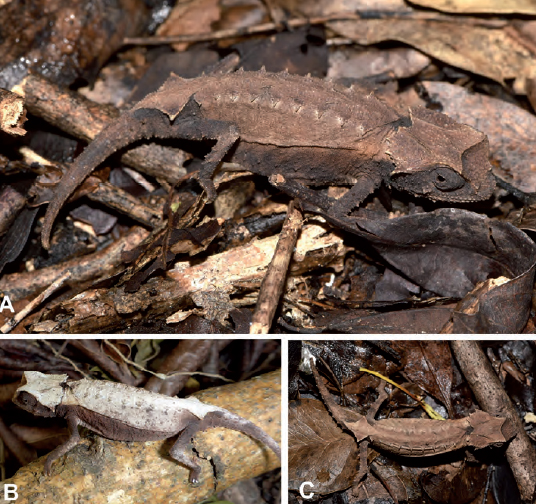The anatomy of chameleons is strongly adapted to their way of life. Tree-dwellers differ in many aspects from ground-dwellers. The pelvic girdle has been little studied anatomically in chameleons so far – a publication from the USA now deals with it in more detail.
For the study, the pelvic girdles of 22 chameleons were isolated from existing microcomputer tomography scans and displayed in 3D. These were measured to 16 different lengths and angles using software. Archaius tigris, Bradypodion damaranum, Calumma gallus, Calumma parsonii parsonii, Chamaeleo zeylanicus, Furcifer balteatus, Kinyongia matschiei, Kinyongia tavetana, Nadzikambia mlanjense and Trioceros quadricornis gracilior were assigned to tree dwellers. Brookesia brygooi, Chamaeleo namaquensis, Palleon nasus nasus, Rhampholeon temporalis and Rieppeleon brachyurus were attributed to ground-dwelling species. The species Bradypodion occidentale, Brookesia ebenaui, Chamaeleo anchietae, Furcifer campani, Rhampholeon spinosus, Rieppeleon kerstenii kerstenii and Trioceros goetzei goetzei were classified as semiarboreal. Mainly males were examined.
As expected, the evaluation showed that tree-dwelling chameleons had narrower, shorter girdles than ground-dwelling ones. The narrower pelvic girdle makes it easier to hide behind branches and flatten the body to the maximum. It also ensures that the body’s centre of gravity is closer to the branch and thus increases stability when climbing. Ground-dwelling chameleons, on the other hand, had larger and wider pelvic girdles. These allow them to step more quickly and provide greater stability when walking on ground surfaces.
How phylogeny and arboreality affect pelvic girdle anatomy of chameleons
Dakota J. John
Honors Thesis 299, University of South Dakota, 2023
DOI: none



